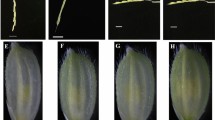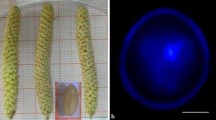Abstract
An isolated microspore culture and green plant regeneration method for rye (Secale cereale L.) was established. Rye isolated microspore androgenesis was genotype-dependent. PG-96M medium supplemented with 6% maltose gave the highest microspore survival rate after 48 h of culture and the highest embryo/callus yield (930 embryos/calli per 100 anthers from cv. Florida 401). Osmotic pressure in the induction medium played an important role. Pretreatment of the anthers with mannitol was beneficial for the microspore culture. Embryos/calli of a relatively younger age and smaller size had a higher regeneration ability, with the best green plant regeneration rate being 6%. Over 150 microspore-derived green plants have been obtained so far. About 90% of the regenerated plants were spontaneous doubled haploids. This is the first report of isolated microspore culture in true rye resulting in androgenic embryogenesis and plant regeneration.
Similar content being viewed by others
Author information
Authors and Affiliations
Additional information
Received: 26 April 1999 / Accepted: 23 November 1999
Rights and permissions
About this article
Cite this article
Guo, YD., Pulli, S. Isolated microspore culture and plant regeneration in rye (Secale cereale L.). Plant Cell Reports 19, 875–880 (2000). https://doi.org/10.1007/s002990000194
Issue Date:
DOI: https://doi.org/10.1007/s002990000194




